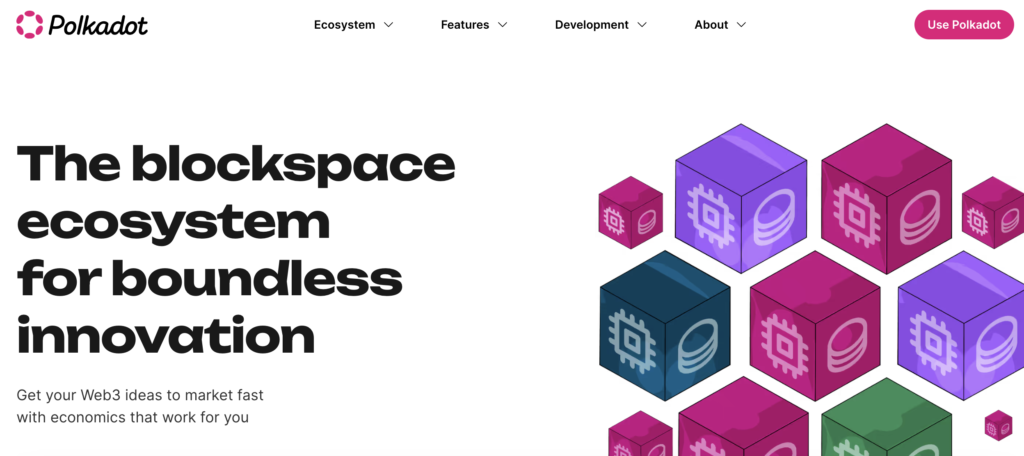Polkadot is a standout project in the blockchain landscape, designed to enable a completely decentralized web where users have control over internet monopolies. It represents a multi-chain framework, often referred to as a “blockchain of blockchains,” facilitating the cross-chain transfer of any data or asset types, not just tokens. This makes it possible for a wide range of blockchains to interoperate.

History of the Project
Developed by the Web3 Foundation, Polkadot was created by Dr. Gavin Wood, one of the co-founders of Ethereum. Polkadot’s development began in 2016, with its initial release following in May 2020. The project has swiftly moved through several stages of development, from an idea to a robust ecosystem. The Web3 Foundation has fostered a growth-oriented community and numerous partnerships, all focused on achieving a decentralized web.
What is Polkadot?
Polkadot is defined as a heterogeneous multi-chain interchange framework, enabling specialized blockchains to connect and share information in a secure trust-free fashion. It addresses key issues in the blockchain space, including interoperability, scalability, and security. By connecting different chains through a common set of protocols, it allows otherwise independent blockchains to communicate and expand their functionalities.
How Polkadot Works?
Polkadot is built on a foundation of cutting-edge technologies tailored to facilitate a highly scalable and interoperable blockchain network. Its distinctive structure and consensus mechanism set it apart from traditional blockchains, offering a novel approach to solving some of the most persistent issues in the blockchain space such as scalability, interoperability, and governance.
Core Technologies
- Relay Chain: The heart of Polkadot, the Relay Chain is responsible for the network’s security, consensus, and cross-chain interoperability. Unlike networks that handle all operations on a single chain, Polkadot’s Relay Chain focuses primarily on security and consensus, delegating most non-essential functions to parachains. This specialization enhances throughput and efficiency.
- Parachains: Independent blockchains that run parallel to the Relay Chain. Parachains are the diverse ‘worker bees’ of Polkadot, each tailored to specific use cases and needs, from identity management to financial services. They leverage the shared security of the Relay Chain but operate independently, processing transactions and creating blocks on their own terms.
- Parathreads: These are similar to parachains but operate on a more economical and flexible basis. Parathreads are ideal for blockchains that don’t require continuous connection to the network. They utilize a pay-as-you-go model, which is cost-effective for less frequent blockchain operations.
- Bridges: Specialized parachains or parathreads that connect Polkadot to external blockchains. These bridges allow Polkadot to communicate and transfer data or tokens with other blockchains like Ethereum, essentially enabling cross-blockchain transfers.
Consensus Mechanism
Polkadot employs a sophisticated consensus mechanism known as Nominated Proof of Stake (NPoS). This mechanism is a variation of the traditional Proof of Stake (PoS) designed to optimize security and efficiency. In NPoS, DOT token holders nominate validators who are responsible for managing the network and creating new blocks. Validators are selected based on their stake in the network, which includes the stakes of nominators who back them.
NPoS is designed to achieve maximum chain security by ensuring that a large number of validators are staked and actively participating in the consensus process. It also encourages fair participation and minimizes the risk of centralization, as nominators can spread their stake across multiple validators.
Blockchain Architecture
The architecture of Polkadot’s blockchain is unique in that it decouples the main responsibilities of traditional blockchains into two separate layers: the Relay Chain and parachains. This design allows each parachain to have its own governance and operate almost entirely independently while still benefiting from the shared security and interoperability provided by the Relay Chain.
Each parachain can be developed using Substrate, a blockchain-building framework created by Parity Technologies. Substrate provides a powerful toolkit for blockchain innovators, offering pre-built components and a robust environment for custom blockchain development. This allows developers to focus on innovation rather than the underlying code, speeding up the deployment and enhancing the functionality of their blockchain solutions.
Differentiation from Other Projects
What sets Polkadot apart from other blockchain solutions is its multi-chain architecture, which addresses scalability by processing multiple transactions on several parachains simultaneously. Furthermore, its flexible consensus mechanism and the ability to connect with external blockchains via bridges give it a unique position in the ecosystem, facilitating greater integration and interoperability across the blockchain space.
What Are Parachain Auctions?
Parachain auctions are a unique and integral aspect of the Polkadot ecosystem, designed to allocate parachain slots on the Relay Chain in a transparent and permissionless manner. These auctions play a crucial role in determining which parachains will be added to the Polkadot network, based on the community’s support and the projects’ commitment of resources.
Purpose of Parachain Auctions
The primary purpose of parachain auctions is to ensure a fair and efficient distribution of the limited parachain slots available on the Polkadot Relay Chain. These slots are highly coveted because they provide the security and interoperability benefits of the Polkadot network. The auction process is designed to discover which projects have the most support from the community, indicating strong user and developer interest and the likelihood of significant contributions to the ecosystem.
Mechanism of Parachain Auctions
Parachain auctions utilize a mechanism known as a “candle auction,” a method historically used in ship auctions. This format is adapted for the blockchain environment to add a layer of unpredictability to the exact ending time of the auction, thereby discouraging last-minute strategic bidding and ensuring a fairer bidding process.
- Bidding Process: Projects interested in obtaining a parachain slot must lock up a certain amount of DOT tokens as a bid. The projects that bid the highest amount of DOT tokens are typically considered for the parachain slot allocation. These DOT tokens are locked up for the duration of the parachain lease, not spent, providing a way for projects to demonstrate their commitment without losing their stake permanently.
- Duration and Lease Periods: Once a project wins a slot, the parachain is given a lease to operate on the Polkadot network for a predetermined period, which can last up to 96 weeks. This period allows projects to operate their parachain while benefiting from the shared security and interoperability features of the Polkadot network. After this period, the parachain must either renew its lease through another auction or leave the network.
- Decentralized Participation: The community can participate in these auctions by supporting their preferred projects. This is typically done through a process called a “crowdloan,” where individuals can contribute their own DOT tokens to increase a project’s chance of winning a slot. These contributors lock up their own tokens to support a project’s bid in return for rewards specific to the parachain, which may include governance tokens, rewards, or a share in the parachain’s future revenues, depending on the individual project’s offering.
Strategic Importance
Parachain auctions are strategically important because they not only dictate the network’s growth trajectory by selecting high-potential projects but also align the interests of various stakeholders in the ecosystem. By requiring projects to lock up substantial amounts of capital, Polkadot ensures that only serious and well-supported projects secure parachain slots, which helps maintain the overall health and security of the network. Additionally, the auction process incentivizes community involvement and investment in the ecosystem, fostering a more vibrant and engaged community.
In summary, parachain auctions are a fundamental element of the Polkadot network, facilitating the decentralized and dynamic allocation of network resources to foster innovation and growth within the blockchain space.
Tokenomics of Polkadot: Understanding DOT
The native token of the Polkadot network, DOT, serves as the central operational pivot around which the ecosystem functions. Understanding whether DOT is a token or a coin is crucial. DOT is technically a coin because it is used within the Polkadot network as a means of facilitating network operations such as governance, staking, and bonding.
Role of DOT in the Polkadot Ecosystem
- Governance: DOT holders have complete control over the protocol. All privileges, which on other platforms are exclusively reserved for miners, are given to the DOT holders. This includes managing exceptional events such as protocol upgrades and fixes.
- Staking: Operation of the network is secured through staking. Participants can stake DOT to nominate validators, and validators themselves must also stake DOT to participate in the network consensus and add blocks to the Relay Chain.
- Bonding: To add new parachains, DOT must be locked up (bonded) in a process similar to staking. This bonding ensures that the parachain slot is secured and the network remains secure. The bonded DOT is locked for the duration of the parachain slot lease and released back to the holder once the lease is over or the parachain is removed.
Emission Model
Polkadot employs an inflationary token model where new DOTs are continuously minted. The inflation rate is designed to be adaptive, meaning it changes based on the total percentage of DOT staked on the network. The target is to have a 50% staking rate, which influences the inflation rate to ensure enough incentivization for network participants to stake and secure the network. If the staking rate is below the target, the inflation rate increases to encourage more staking. Conversely, if the staking rate is above the target, the inflation decreases.
Token Supply and Distribution
Polkadot’s initial token supply was generated through a series of public sales and distributions to early investors and the team. The total supply at genesis was approximately 1 billion DOT tokens, which was redenominated from the old DOT in August 2020 by a factor of 100 to increase the granularity of the token.
Market Dynamics
The value of DOT fluctuates based on market conditions, including demand for parachain slots and the overall interest in the Polkadot network as a hub for blockchain innovation. The price of DOT is also influenced by its inflationary nature; as new tokens are minted, the supply increases. The economic activities within the Polkadot ecosystem, such as the parachain auctions and the number of DOTs staked for network security and governance, play a critical role in determining the DOT’s value.
Understanding the tokenomics of DOT provides insights into its critical role within the Polkadot ecosystem, not just as a medium of transaction but as a fundamental component of network security, governance, and expansion. This dual role underscores the intrinsic value DOT holds in facilitating and securing a vast network of interoperable blockchains.
Where to Buy the DOT Coin?
For those interested in acquiring DOT, the native coin of the Polkadot network, there are several reputable cryptocurrency exchanges that provide access to trading and purchasing. Here are some of the primary platforms where DOT is available:
- Binance: One of the largest and most well-known cryptocurrency exchanges globally, offering extensive trading pairs, including DOT against cryptocurrencies and fiat currencies.
- HTX (formerly Huobi): A major exchange platform that offers a variety of cryptocurrencies, including DOT. It is known for its liquidity and a wide range of crypto-to-crypto trading pairs.
- MEXC Global: Offers DOT trading and is known for its user-friendly interface and effective platform security.
- Bybit: Known primarily for derivatives trading, Bybit also offers spot trading in cryptocurrencies like DOT.
- KuCoin: A popular choice among cryptocurrency enthusiasts, KuCoin offers DOT trading and is appreciated for its wide range of cryptocurrencies and user-friendly platform.
- Bitfinex: Offers a sophisticated trading platform with high liquidity for DOT, catering mostly to professional traders.
Each of these exchanges provides different interfaces, trading features, and fee structures, so potential buyers should consider their specific needs and preferences when choosing an exchange.
Where to Store the DOT Coin?
Proper storage is crucial for securing DOT coins. Here are several wallet options that support DOT and offer various features to meet different needs for security, accessibility, and functionality:
- Polkadot.js Browser Extension: An official wallet specifically designed for the Polkadot and Substrate networks. It allows users to interact directly with the Polkadot blockchain through a browser.
- Ledger Hardware Wallet: For those seeking the highest security level, Ledger hardware wallets offer offline storage for DOT. They support the Polkadot network and allow users to manage their DOT securely through Ledger Live.
- Trezor Hardware Wallet: Another secure hardware wallet option that supports DOT. It provides offline storage and the ability to manage coins directly from the Trezor interface.
- Fearless Wallet: A mobile wallet designed specifically for the Polkadot and Kusama networks. It offers a user-friendly interface and direct interaction with DeFi platforms and parachain auctions.
- SubWallet: A browser extension that allows users to interact with DApps on the Polkadot and Kusama networks. It provides a convenient way to manage DOT and participate in network activities.
These wallets offer a range of functionalities, from basic transaction capabilities to more complex interactions with the Polkadot network, such as staking and participating in governance. When choosing a wallet, consider factors such as security features, ease of use, and compatibility with different devices.
Prospects and Development Forecast
The growth of Polkadot is founded on its revolutionary multi-chain architecture, which allows for unprecedented scalability and interoperability in the blockchain space. Its ability to connect various blockchains into a single unified network has positioned it as a key player in the future development of decentralized technologies.
Growth Drivers
Technological Innovation: Polkadot continues to advance its core technologies, with ongoing improvements to its parachain functionality, governance models, and consensus mechanisms. This commitment to innovation attracts developers and projects looking to leverage its scalable and interoperable ecosystem.
Strategic Partnerships: Polkadot has established significant partnerships with various stakeholders in the blockchain and technology sectors. These partnerships help expand its ecosystem and enhance its functionalities. Notable partners include:
- Chainlink: Integrating decentralized oracle networks to feed real-world data to Polkadot’s parachains.
- Plasm Network: A scalable smart contract platform on Polkadot that supports Ethereum and layer-2 solutions like Optimistic Rollups.
- Phala Network: A privacy-preserving cloud computing service, which enhances Polkadot’s capabilities in handling sensitive data securely.
Community and Developer Engagement: The active and growing community of developers contributing to the Polkadot ecosystem ensures continual development and innovation. This community support is vital for both maintaining the network and developing new applications.
Development Forecast
The development trajectory of Polkadot is expected to be significantly positive, driven by the ongoing adoption of its technology in various sectors, including finance, identity verification, and decentralized data services. As blockchain technology becomes more mainstream, Polkadot’s role in enabling different blockchains to communicate and share resources will likely become increasingly important.
The Ecosystem of Polkadot
The Polkadot ecosystem comprises a robust collection of projects, each utilizing the network’s decentralized and interoperable framework. Some key components include:
- Acala Network: A decentralized finance hub and stablecoin platform that provides financial services to the Polkadot ecosystem.
- Moonbeam: An Ethereum-compatible smart contract platform on Polkadot that allows developers to deploy existing Ethereum applications in Polkadot’s environment.
- Kusama: Often described as Polkadot’s “canary network,” Kusama is an experimental blockchain platform designed to provide a testbed for blockchain projects looking to later launch on Polkadot.
- Ocean Protocol: Partners with Polkadot to bring data exchange functionalities to the ecosystem, facilitating a Web3 data economy.
- Bifrost: A protocol providing staking liquidity by enabling staked assets to be converted into vTokens that can be used in various DeFi applications.
These projects illustrate the diverse applications and services supported by Polkadot, highlighting its potential as a foundational technology in the future blockchain landscape. The ecosystem is poised for further growth as it continues to attract innovative projects and partnerships.
Conclusion
Polkadot stands out in the blockchain environment due to its unique multi-chain architecture, which not only enhances scalability and interoperability among blockchains but also represents a significant advance towards a more decentralized internet. As developers continue to explore and expand its ecosystem, Polkadot’s strategic potential to reshape the blockchain landscape remains high, making it an attractive project for advanced users and investors within the cryptocurrency space.






